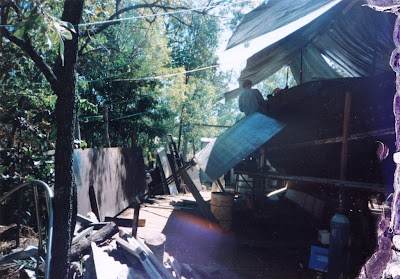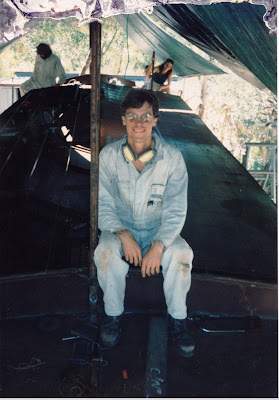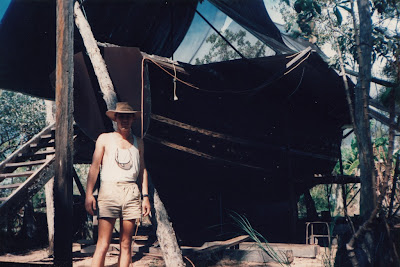The Cabin sides plates (3mm) were fitted to the 1" flat bar gunwales between the coachroof ends.
NB: I thought it prudent NOT to cut any portholes into it at this stage, these were left untill much later after plate fitting and weld up completed. This was to allow the steel plate to keep a fair curve.
1" flat bar stringers were then fitted into slots pre-cut in the deck beams and tacked into position to complete the deck framework.
Incase your wondering, the purple things on the far right are not alien life-forms. These photos went through a few cyclones in old caravans unattended but were foretunately saved in time.
Getting two 6x1.5m steel sheets onto the deck was solved by using 3 angle-steel ramps which were trimmed and tacked onto the deckedge. The plates were moved onto the ramps as seen above.
Then my 1/2 ton chain block helped haul them up the ramps to the deck edge.
And onto the deck. Thanks the help from visiting friends the Rusts and my brother Max from the land of the long white cloud.
Hans and Max are are both experienced yachtsmen and sail at the Russell Boating club in the Bay of Islands, NZ. Nearby Opua is often the first port of call by yachts escaping the South Pacific cyclone season (Nov-March), besides being a great cruising ground there's also good boat maintenance yards.
The second deck sheet - both sheets were stood on edge and wirebrushing , anti-corrosion treatment given to the areas under the deck stringers before fitting. On the 35ft version these sheets were a little short so about 40cm extra needed to be added to complete the raised deck, i added this to the foward end.
The foredeck was similarly fitted. Some steel framed and wooden decked scafolding was made up around the hull about 4ft off the ground to make the cabin welding and bulwark fitting phase easier.
MIG welding
A 130amp MIG welder was used for alot of the 3mm deck work. It runs on any 10amp standard household electrical socket. It concentrated the heat due to a 0.9mm feed wire however seemed to produce alot less heat overall into the surrounding sheets which reduced distortion allot. This allowed for longer weld runs without plate distortion.
An argon arc gas sheild also made the welds easier and better. The mig is easier to weld with than the stick welder, just aim and pull the trigger. Once the feed speed and heat are set correctly the only thing to do is watch where you are going and move along the weld. The Argon gas bottle was hired from a local industrial gas supplier (along with the oxygen and acetylene bottles for oxy-cutting).
The MIG only had a short feed cable from box to weld-gun, so the downside was moving the box around more than the arc welder with its long lead. Also the MIG doesnt like working overhead welds as weld spatter quickly builds up in the gas sheild cowl, its far better downhand.








